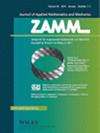A Hermitian Cn finite cylindrical layer method for 3D size‐dependent buckling and free vibration analyses of simply supported FG piezoelectric cylindrical sandwich microshells subjected to axial compression and electric voltages
IF 3.2
4区 工程技术
Q1 MATHEMATICS, APPLIED
Zamm-zeitschrift Fur Angewandte Mathematik Und Mechanik
Pub Date : 2023-09-22
DOI:10.1002/zamm.202300472
引用次数: 0
Abstract
Abstract Within the framework of the consistent couple stress theory (CCST), we develop a Hermitian C n ( n = 1, 2) finite cylindrical layer method (FCLM) for carrying out the three‐dimensional (3D) analysis of the size‐dependent buckling and free vibration behaviors of simply supported, functionally graded (FG) piezoelectric cylindrical sandwich microshells. The microshells of interest are placed under closed‐circuit surface conditions and subjected to axial compression and electric voltages. We derive a 3D weak formulation based on Hamilton's principle for this study. In the resulting formulation, the microshell is artificially divided into n l microlayers, with the elastic displacement components and the electric potential selected as the primary variables. By incorporating a layer‐wise kinematic model into our weak formulation, we develop a Hermitian C n FCLM, which can be used for analyzing FG piezoelectric cylindrical sandwich microshells. Each primary variable is expanded as a double Fourier series in the in‐surface domain and is interpolated in the thickness direction using Hermitian C n polynomials. The accuracy and the convergence rate of our Hermitian C n FCLMs are validated by comparing the solutions they produce for FG piezoelectric cylindrical macroshells and FG elastic cylindrical microshells with the relevant exact and approximate 3D solutions which have been reported in the literature. The material length scale parameter of our FCLMs is set at zero in the comparison made with the FG piezoelectric macroshells. In contrast, the piezoelectric and flexoelectric effects are ignored in the comparison made with the FG elastic microshells. The impact of some essential factors on the critical load, critical voltage, and natural frequency of simply supported FG piezoelectric cylindrical sandwich microshells is assessed. The important factors are identified as piezoelectricity, flexoelectricity, the material length scale parameter, the inhomogeneity index, the radius‐to‐thickness ratio, the length‐to‐radius ratio, and the magnitude of the applied voltage and the applied load.基于hermite Cn有限柱层法的简支FG压电夹层微壳在轴向压缩和电压作用下的三维屈曲和自由振动分析
摘要在一致耦合应力理论(CCST)的框架下,我们建立了一种hermite C n (n = 1,2)有限圆柱层法(FCLM),用于对简支功能梯度(FG)压电圆柱夹层微壳的尺寸相关屈曲和自由振动行为进行三维(3D)分析。我们感兴趣的微壳被置于闭环表面条件下,并经受轴向压缩和电压。我们推导了一个基于Hamilton原理的三维弱公式。在所得到的公式中,微壳被人为地划分为n个微层,并选择弹性位移分量和电势作为主要变量。通过将分层运动模型纳入弱公式,我们开发了一个厄米C n FCLM,可用于分析FG压电圆柱形夹层微壳。每个主变量在曲面域中展开为二重傅立叶级数,并使用厄米多项式在厚度方向上进行插值。通过与文献中报道的精确和近似三维解进行比较,验证了我们的hermite C n FCLMs的精度和收敛速度。在与FG压电大壳的对比中,我们的fclm材料长度尺度参数设为零。相比之下,在与FG弹性微壳的比较中忽略了压电效应和柔电效应。分析了一些关键因素对简支FG压电圆柱夹层微壳临界载荷、临界电压和固有频率的影响。重要的影响因素包括压电性、挠性、材料长度尺度参数、非均匀性指数、半径与厚度比、长度与半径比、外加电压和外加载荷的大小。
本文章由计算机程序翻译,如有差异,请以英文原文为准。
求助全文
约1分钟内获得全文
求助全文
来源期刊
CiteScore
3.30
自引率
8.70%
发文量
199
审稿时长
3.0 months
期刊介绍:
ZAMM is one of the oldest journals in the field of applied mathematics and mechanics and is read by scientists all over the world. The aim and scope of ZAMM is the publication of new results and review articles and information on applied mathematics (mainly numerical mathematics and various applications of analysis, in particular numerical aspects of differential and integral equations), on the entire field of theoretical and applied mechanics (solid mechanics, fluid mechanics, thermodynamics). ZAMM is also open to essential contributions on mathematics in industrial applications.

 求助内容:
求助内容: 应助结果提醒方式:
应助结果提醒方式:


